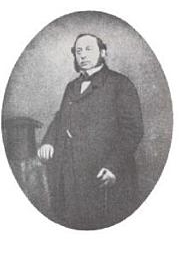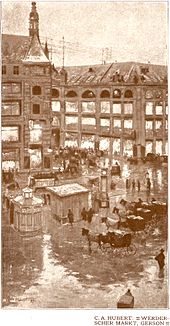Herrmann Gerson
Herrmann Gerson (born February 28, 1813 in Koenigsberg (Neumark) , † December 6, 1861 in Berlin ) was a Berlin Jewish fashion designer and operator of one of the leading specialist fashion stores in Berlin.
Life
He was born the stag Gerson Levin, son of the merchant Levin Gerson. In 1835 he came to Berlin from Königsberg , where, like many other Jews, he wanted to build a living. In the year of his arrival he acquired the necessary "Jewish Citizenship Letter" and took the name Hermann Gerson. In Berlin in 1836 he was one of the two founders of the Wald & Gerson business in the “ Royal Building Academy No. 3 “, which offered white embroidery, blondes, tulle, edging, curtain fabric and white goods . From 1839 he ran the company under his own name.
In 1841, Gerson began trading in mass-produced women's and men's coats. He was quickly successful, acquired the title of royal purveyor to the court and in 1848 moved to the neighboring Werderscher Markt 5. At that time he already employed 5 master craftsmen, 3 directors and 120 to 140 women workers in the workshop. 100 clerks and supervisors were employed for the shop and for service. Around 1,500 tailors worked for him outside the home, including 150 masters. The Gerson clothing store was considered the first department store in Berlin and became known for its exceptionally exclusive, but also very expensive women's fashion that did not need to shy away from international comparison. As a purveyor to the court, it later supplied the royal and imperial houses of Prussia, Russia, Great Britain and Ireland as well as Sweden and Norway and the German Empire. Herrmann Gerson and Valentin Manheimer were at the beginning of the flourishing Berlin clothing industry. Among other things, he received the order to manufacture the coronation mantle for Wilhelm I.
Herrmann Gerson died in Berlin in 1861 at the age of 48. He was buried in the Jewish cemetery at Schönhauser Allee . The grave is preserved.
The company continued to flourish under its heirs and in 1891 employed 240 skilled workers in the shop alone. In addition, she worked for 1,500 people in homework . In 1894 the Herrmann Gerson company was the largest in the industry with annual sales of 30 million marks. His brother Julius Gerson lived in Villa Bellevuestrasse 10 from 1864.
literature
- Hermann Gerson . In: Gerhild Komander (Ed.): The first Berlin telephone directory 1881 . Berlin 2006 p. 107 ( partially digitized ).
- Gesa Kessemeier: A fairy temple of fashion or a forgotten family, an obliterated place. The Freudenberg family and the “Herrmann Gerson” fashion house Hentrich & Hentrich Verlag Berlin, Berlin 2013, ISBN 978-3-95565-018-6 .
- Gesa Kessemeier: Herrmann Gerson. The first Berlin fashion department store (= Jewish miniatures, vol. 185); Berlin: Hentrich & Hentrich 2016.
Web links
- Magnet for fashion designers . In: Der Spiegel . No. 1 , 1993 ( online ).
- Hermann Gerson . In: District lexicon of the Luisenstädtischer Bildungsverein
Individual evidence
- ↑ a b c Uwe Westphal: Berliner Konfektion und Mode - 1839-1939 - The destruction of a tradition . Edition Hentrich, Berlin, Sites of the History of Berlin Volume 14, 1st edition 1986, p. 15.
- ^ Hans-Jürgen Mende : Lexicon of Berlin burial places . Pharus-Plan, Berlin 2018, ISBN 978-3-86514-206-1 , p. 352.
- ^ Gesa Kessemeier: Herrmann Gerson. The first Berlin fashion department store. Hentrich & Hentrich Verlag, Berlin 2016, p. 34-37 .
- ^ Bellevuestraße 10 - History , accessed on February 4, 2013
| personal data | |
|---|---|
| SURNAME | Gerson, Herrmann |
| BRIEF DESCRIPTION | Wholesaler, clothing manufacturers |
| DATE OF BIRTH | February 28, 1813 |
| PLACE OF BIRTH | Chojna |
| DATE OF DEATH | December 6, 1861 |
| Place of death | Berlin |



